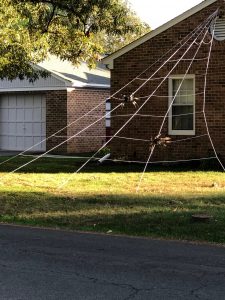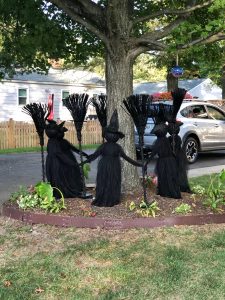October 14, 2021
Another misty morning turned into warm sunshine day. The house was abuzz with contractors finishing the painting and preparing for the flooring in the basement. Went for a walk this afternoon and started a new audiobook—another Inspector Gamache (book 14). I’m trying to pace myself because I want her series to go on forever. The neighborhood is full of Halloween decorations this year. There must have been a surplus of plastic skeletons because every third house seems to have them in various poses on their front porches or hanging from trees or creeping around house corners. I’m even seeing spider, dog, and cat skeletons. I guess the manufacturers don’t know that spiders don’t have bones, but I miss the point, I’m sure. One house has dozens of skeletons all over the yard and on the roof. I’ll be sure to get a picture of them this year.
Tonight I had my Tree Wisdom class on Zoom. This week’s assignment video discussed Suzanne Simard’s research about how trees are connected and communicate with one another via their roots and an underground network of fungi. Trees form communities and actually help one another by sending warning signals when they’re under attack from insects or stressed from environmental conditions. They also share nutrients—the healthier ones with surplus nutrients send their stash to trees in need. In fact, there’s probably more activity going on underground than above ground. Trees are symbiotically connected below the surface. Likewise humans are connected beneath the surface, yet we refuse to see it. We want to believe we are all individuals that must preserve our individuality instead of behaving like the symbiotic organisms we are, in community.
When I studied forestry in college we didn’t really know any of this; it was all about growing trees as big as possible as quickly as possible to cut them down for our use. We were taught we had to thin forests to reduce competition; that trees competed for resources and they needed Man’s “help” to be released from imprisonment by other trees. Simultaneously, we were taught not to anthropomorphize nature; imposing feelings on non-human living things was folly and feeble-minded. Doing so blinded us to the goal of forest and wildlife management. Well, what a bunch of hooey! Who’s doing the anthropomorphizing by projecting our human-centered belief that living things must essentially be killed to reduce competition? Who’s made the assumption that trees compete for resources just like humans? Time to start listening more to trees.





Comments
October 14, 2021 — No Comments
HTML tags allowed in your comment: <a href="" title=""> <abbr title=""> <acronym title=""> <b> <blockquote cite=""> <cite> <code> <del datetime=""> <em> <i> <q cite=""> <s> <strike> <strong>